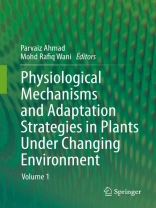The global population is growing at an alarming rate and is anticipated to reach about 9.6 billion by the end of 2050. Addressing the problem of food scarcity for budding population vis-à-vis environmental changes is the main challenge plant biologists face in the contemporary era. Plant growth and productivity are scarce in many areas of the world due to a wide range of environmental stresses. The productive land is dwindling progressively by various natural and anthropogenic means that lead to enormous crop losses worldwide. Plants often experience these stresses and have the ability to withstand them. However, when the stress exceeds the normal tolerance level, plants accumulate organic osmolytes, osmoprotectants, cryoprotectants and antioxidant enzymes, which helps them tolerate these stresses and assist in their acclimatization towards the particular ambiance needed for maintaining their growth and development.
Physiological Mechanisms and Adaptation Strategies in Plants Under Changing Environment, Volume 1 discuss drought and temperature stresses and their mitigation through different means. This volume illuminates how plants that are bombarded by diverse and changing environmental stimuli, undergo appropriate physiological alterations that enable their survival. The information covered in the book is also useful in building apposite strategies to counter abiotic and biotic stresses in plants. Written by a diverse group of internationally renowned scholars, Physiological Mechanisms and Adaptation Strategies in Plants Under Changing Environment, Volume 1 is a concise yet comprehensive resource that will be beneficial for the researchers, students, environmentalists and soil scientists of this field.
Содержание
Mechanisms and Adaptation of Plants to Environmental Stresses: A Case of Woody Species.- Drought Tolerance: Roles of Organic Osmolytes, Growth Regulators and Mineral Nutrients.- Influencing the Product Quality by Applying Drought Stress during the Cultivation of Medicinal Plants.- Water Scarcity and Water Stress in Agriculture.- Biotechnology for Drought and Salinity Tolerance of Crops.- Effect of Salinity on Plants and the Role of Arbuscular Mycorrhizal Fungi and Plant Growth Promoting Rhizobacteria in Alleviation of Salt Stress.- Cash Crop Halophytes-The Ecologically and Economically Sustainable Use of Naturally Salt Resistant Plants in the Context of Global Changes.- Effect of Heat Stress on Growth and Crop Yield of Wheat (Triticum aestivum).- Low Temperature Stress in Plants: An Overview of Roles of Cryoprotectants in Defense.- Lignins and Abiotic Stress: An Overview.- Humic Substances and Plant Defense Metabolism.- Mitochondrial Respiration: Involvement of the Alternative Respiratory Pathway and Residual Respiration in Abiotic Stress Responses.
Об авторе
Dr. Parvaiz Ahmad Department of Botany, Sri Pratap College, Srinagar, Jammu and Kashmir, India
Dr. Mohd Rafiq Wani Department of Botany, Govt. Degree College (Boys), Anantnag, Jammu and Kashmir, India












